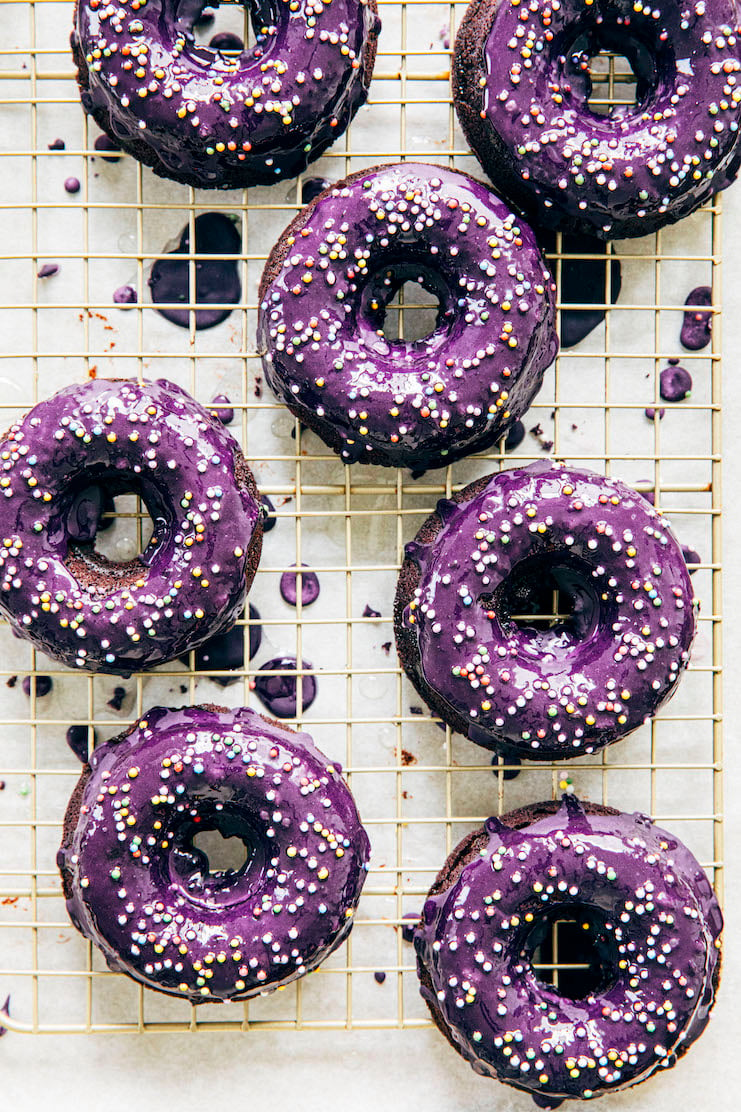
About These Small Batch Baked Ube Mochi Donuts
These baked ube mochi donuts are crispy on the outside, soft and chewy on the inside, and packed with lots of ube flavor thanks to ube jam and extract in both the batter and glaze! The best part? The baked ube mochi donuts are 100% gluten free thanks to the use of mochiko sweet rice flour. The recipe is also small batch, and makes only 6 donuts!
For more unique breakfast recipes on Hummingbird High, check out my Breakfast recipe collection! Popular recipes include these Malasadas (Hawaiian Donuts).
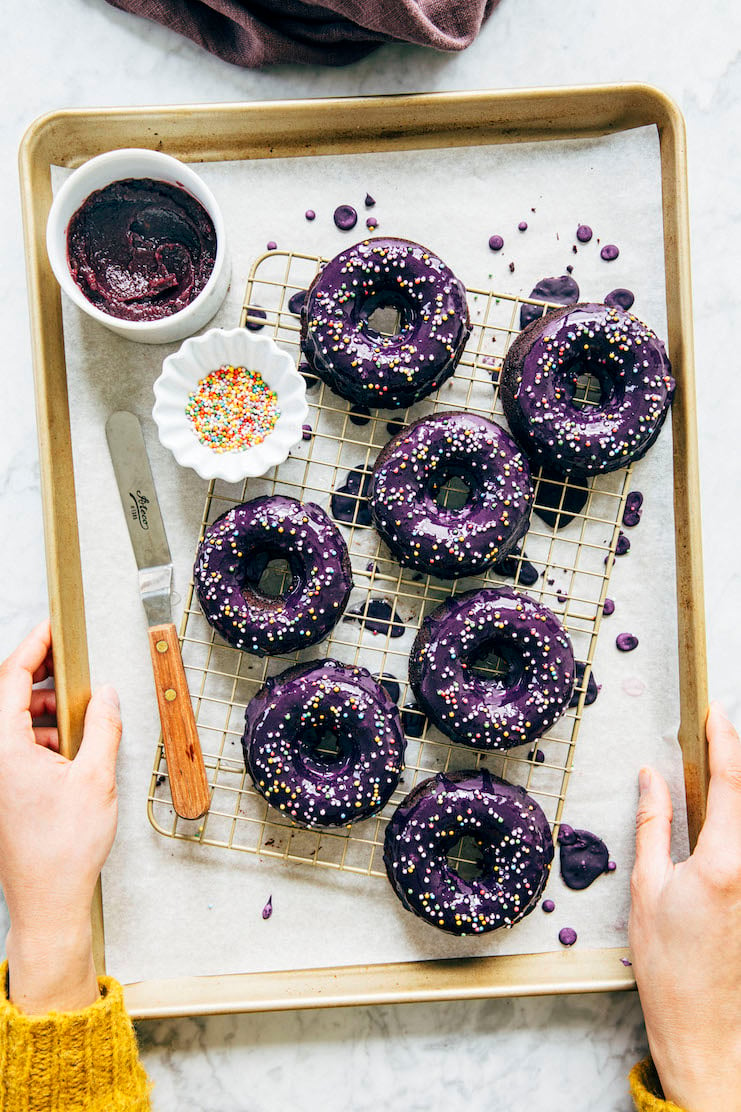
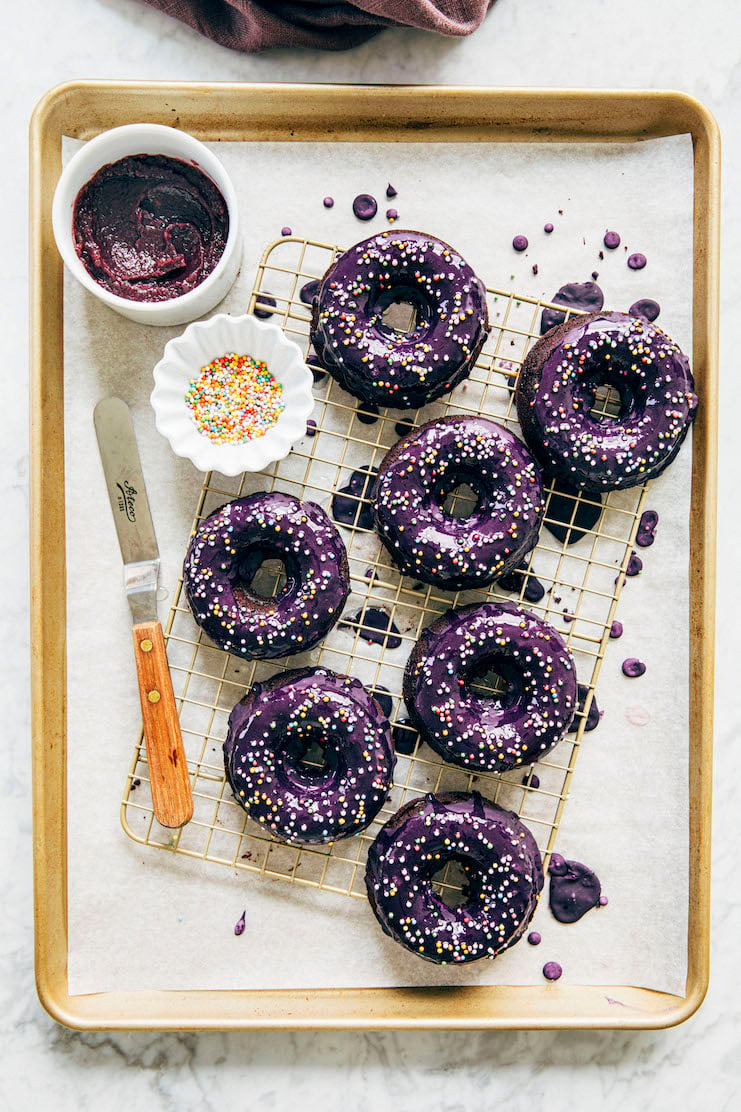
Ingredients and Substitutions
Now that I’ve convinced you to make these donuts, let’s talk about some key ingredients and their substitutions:
- Mochiko Sweet Rice Flour. My hands down, all-time favorite brand of sweet rice flour is Mochiko Sweet Rice Flour by Koda Farms. You can find mochiko sweet rice flour in the Japanese or flour section of almost every major Asian grocery store. I’ve also started seeing it in the Asian and/or gluten-free baking sections of major grocery stores like Safeway, Whole Foods, and even Target! You can also buy it online on Amazon. However, I don’t recommend doing so because you can only buy it in bulk and a box at a grocery store typically costs less than $5.
- Kosher Salt. In my cookbook, I argue that kosher salt is the best salt for baking recipes. But you can replace the kosher salt in the recipe with table salt. Just use half the amount listed in the recipe when you do!
- Ube Halaya (Ube Jam). Ube halaya jam is typically found in the “Filipino” aisle of any Asian supermarket, close to jars of preserved jackfruit, macapuno (a coconut hybrid much beloved in the Philippines), and other fruits commonly found in the country. In the US, the brand I most commonly see is Monika. If you can’t find it at the store, make your own with my recipe using frozen ube!
- Ube Extract. In the United States, there’s only a handful of brands that make ube extract: McCormick and Butterfly. I’m partial to McCormick because they’re a huge company that also makes other high-quality spices, herbs, and extracts. Their ube extract also contains actual yam and ube in it. Although most McCormick spices and extracts are available in most supermarkets, you need to go to a specialty Asian market to source the ube extract. Most Asian supermarkets have a baking aisle.
- Purple Food Coloring. For these donuts, I used a purple from this “Nifty Fifty” Americolor food coloring set. You can also buy as an individual bottle online. Technically, you don’t need to use purple food coloring to make these donuts. But your donuts won’t come out the same color as mine. That’s because although both ube halaya and ube extract are purple, they don’t have enough natural pigment to really dye the donuts a deep purple on their own.
- Whole Milk. While testing this recipe, I found that you can use skim, low-fat, or non-fat milk instead of whole milk. You can also use plant-based milks like almond, coconut, soy, or oat. However, be mindful that using an alternative milk with “strong” flavors (like coconut or oat milk) will impart their flavors into the donuts, too. Specifically, your ube donuts might have a subtle coconut or oat milk flavor to them, too.
I can’t find ube extract. Can I still make these baked ube mochi donuts?
You technically can. However, I don’t recommend it. Why? I mentioned earlier that ube has an incredibly subtle flavor. Without the extract, I think you’d find these donuts bland! Yes—even if you used ube halaya jam.
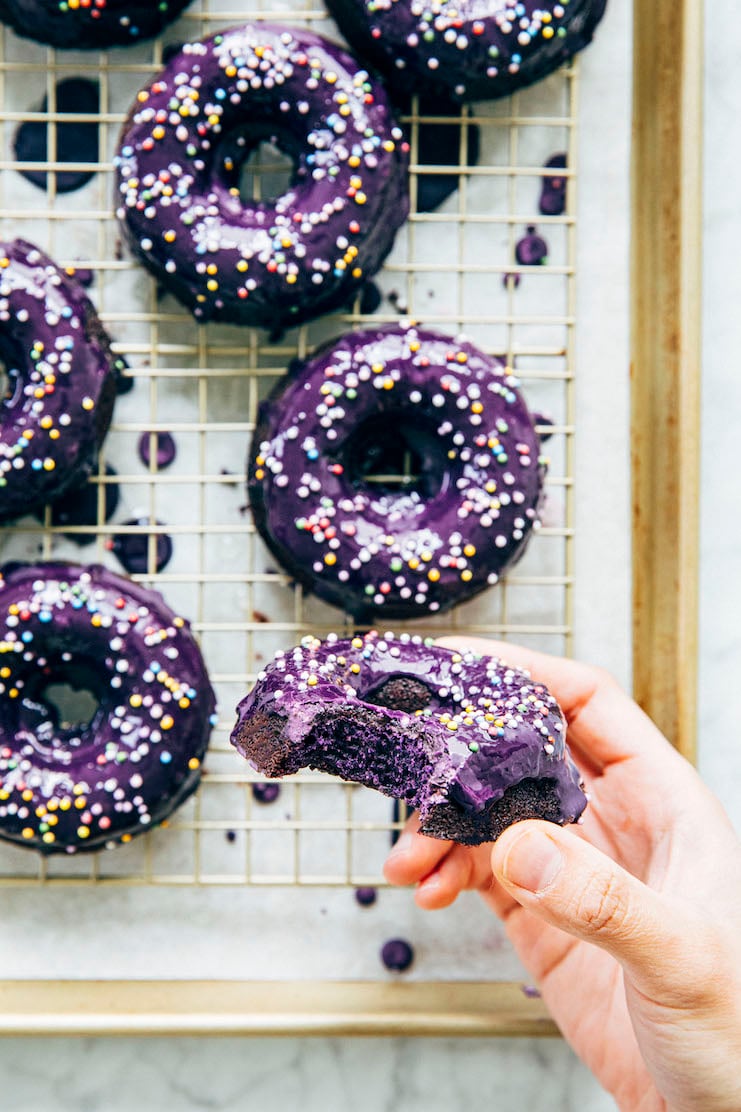
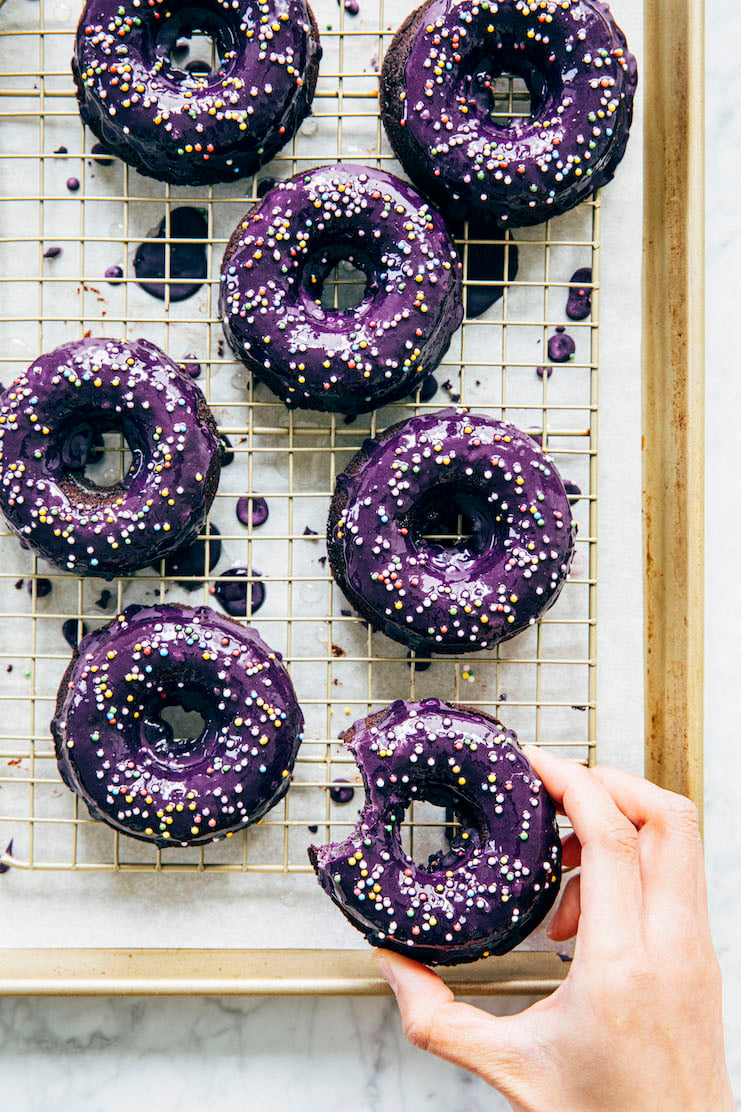
Recipe Troubleshooting and FAQ
What donut pan do you recommend to make baked ube mochi donuts?
I recommend this Wilton donut pan. I used to use this one by Williams Sonoma, but then realized it made much smaller donuts than the Wilton pan! This is a problem for most donut pan recipes—many are designed for the Wilton donut pan size.
That being said, you don’t have to use the Wilton donut pan. You can use whatever is cheapest and available on Amazon. However, I recommend getting a light-colored metal pan like this one by Mrs. Anderson. Darker pans absorb more heat in the oven, leading to overbaked goods.
I also suggest skipping the silicone donut pan varieties and opting for metal. Silicone pans don’t crisp up the mochi donut crusts in the same way as the metal pans. Your mochi donuts will come out of the oven with a soft crust.
Help! My baked ube mochi donuts didn’t rise. What did I do wrong?
Don’t panic!
First of all, these baked ube mochi donuts don’t rise in the same way as traditional cake donuts. That’s why I instruct you to fill the donut pan cavities all the way up to the brim with batter! Their bottoms will be flat—in fact, you can see that’s the case for my donuts in these pictures, too.
So rest assured: if your donuts are flat on the bottom, that’s what they’re supposed to look like!
Best Recipe Tips
Ingredient Tip
- Wondering what to do with your leftover ube halaya jam and extract? Check out these other delicious ube recipes on Hummingbird High: Ube Babka, Ube Cinnamon Rolls, Ube Crinkle Cookies, and Ube Layer Cake.
Technique Tips
- To save yourself a dish, melt the butter in a large bowl. This bowl will eventually become your batter bowl! You add the sugars, eggs, and remaining ingredients directly to the melted butter in this bowl.
- Don’t panic if the butter and sugar turns lumpy once you mix them together! This is normal, I promise. Add the egg yolks one at a time—doing so will smoothen out the mixture. I add the sugar first to the melted butter first to bring its temperature down and ensure that it doesn’t accidentally scramble the egg yolks.
- Most baking recipes instruct you to spray your pan with cooking spray as the first step. However, in this recipe for baked ube mochi donuts, I instruct you to do so only right before filling the donut pan with batter. If you spray the pan too early, the cooking spray has a tendency to slide down the sides of the pan and pool at the bottom of each donut cavity! This excess oil gives the donuts an unattractive color and texture. Simply avoid it by spraying the donut pan right before filling it with batter.
- After you’ve sprayed your pan, use a liquid measuring cup or pitcher with a spout to pour the batter into the donut pan cavities. The batter is really liquidy—a liquid measuring cup or pitcher is your best bet to filling the pan without making a mess! You’ll need to fill each cavity all the way up to the top. Don’t worry! The donut batter won’t overflow since it won’t rise too much.
Video Tutorial for The Recipe
Use the video player below to watch my Instagram Story tutorial on how to make these small batch baked ube mochi donuts! You can click on the left and right hand sides of the frame to skip backwards and forwards through the different recipe steps. You can also hit the frame to “pause” it accordingly.
Alternatively, head to my Instagram profile to watch these Stories! The circles underneath my bio indicate saved Instagram Story highlights for various recipes. Click on one of the circles to play the video tutorial for the recipe. You may need to swipe left or right to find these baked ube mochi donuts.
Get the Recipe: Small Batch Baked Ube Mochi Donuts Recipe
Ingredients
For the Baked Ube Mochi Donut Batter
- ⅔ cup (3.5 ounces or 100 grams) mochiko sweet rice flour
- ½ teaspoon baking powder
- ¼ teaspoon kosher salt
- 2 Tablespoons (1 ounce or 28 grams) unsalted butter, melted and cooled slightly
- 6 Tablespoons (2.65 ounces or 75 grams) granulated sugar
- 2 large egg yolks, at room temperature
- 2 Tablespoons (1 ounce or 28 grams) ube halaya jam
- ¾ teaspoon ube extract
- ½ teaspoon purple food coloring
- ½ cup plus 1 Tablespoon (4.5 ounces or 128 grams) whole milk, at room temperature
For the Ube Glaze
- 1 ½ teaspoons ube halaya jam
- 2 teaspoons whole milk, separated into 1 ½ teaspoon and ½ teaspoon portions
- ½ cup (2 ounces or 57 grams) confectioners' sugar, sifted
- 1 teaspoon ube extract
- sprinkles, for garnish
Equipment
- a donut pan
- a liquid measuring cup or pitcher with a spout
Instructions
For the Small Batch Baked Ube Mochi Donuts
- First, make the donuts. Position a rack in the center of the oven and preheat the oven to 350°F.
- Mix the dry ingredients. In a small bowl, whisk together the mochiko sweet rice flour, baking powder, and kosher salt.
- Mix the wet ingredients. In a medium bowl, whisk together the butter, sugar, and egg yolks until combined. Add the ube jam, ube extract, and purple food coloring and whisk until combined. Gradually whisk in the milk until just combined.
- Add the dry ingredients. Gradually mix in the dry ingredients into the wet ingredients until just combined. Pour the batter into a liquid measuring cup or pitcher with a spout.
- Prep the donut pan. Lightly spray the cavities of a donut pan with cooking spray. Use the liquid measuring cup to pour the batter into the cavities, filing each cavity completely up to its brim with batter.
- Bake the donuts. Bake for 35 minutes. When done, the top of each donut should bounce back when gently pressed and a skewer inserted into the center of the cake should come out with a few crumbs attached. Cool the donuts in the pan for 5 minutes, then turn out to cool completely on a wire rack before glazing.
- Make the glaze. In a medium bowl, whisk together the ube jam and milk. Add the confectioners' sugar, ¼ cup (1 ounce or 28 grams) at a time, whisking until completely incorporated and smooth before adding the next batch of sugar. Once the glaze is smooth, whisk in the ube extract. The glaze will be thick at this point—loosen it by whisking in the remaining ½ teaspoon milk.
- Glaze the donuts. Working quickly, dip the top of a donut in the glaze and quickly flip it up so that the glazed side is upright. Place on a wire rack to let any excess glaze to drip off. Garnish immediately with sprinkles. Repeat with remaining donuts.
- Serve and store. Serve at room temperature. You can serve immediately after glazing, or wait 1 to 2 hours for the glaze to dry and harden. The donuts are best on the day that they're made, but can be stored in an airtight container at room temperature for up to 2 days.
Notes
Can you freeze baked ube mochi donuts?
Although you can technically freeze a baked ube mochi donut, I don’t recommend it. Why? It’s a bit like freezing a regular donut. The magic of a mochi donut (and a regular donut, for that matter) lies in its texture. If you freeze the mochi donuts and bring them back to room temperature for serving, it will no longer have it signature crispy exterior. Furthermore, the glaze will be a sticky, wet mess! You can try freezing the baked ube mochi donuts unglazed and reviving them in an air fryer or oven per my instructions above. However, I still don’t recommend it. This is the type of baked good that’s worth making from scratch each time.get new recipes via email:
Did you make this recipe?
Please leave a comment and rating for the recipe using the form below!
Your ratings make it easier to find the recipe online, and I’m always looking for ways to improve Hummingbird High.


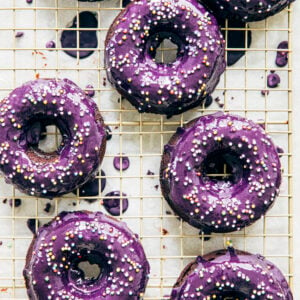


I love love love LOVE how you break down everything into such great detail — from the popularity of mochi donuts to rice flours 101. Can’t wait to try the recipe :)!
AAAHHHHH This looks absolutely amazing! You are always so creative and meticulous!
I couldn’t wait to try this and I am over the moon that I did!!! Soft, slightly chewy, not overly sweet and don’t get me started on that gorgeous purple color!!! It took a lot of willpower not to eat them all at once.
As always, your incredibly clear instructions brought this recipe together easily. In making the icing, I really made sure the ube jam was incorporated well with the milk, without any lumps. Also adding 1/4 cup at a time of confectioners sugar was great advice. I was a little intimidated about dipping the donuts into the icing, but it was easy. The consistency was perfect and I had very little run off. Another outstanding recipe!!! Thank you✨
These ube mochi donuts are sooo delicious and easy to make! They have a perfect ube flavor with a soft and chewy texture! My boyfriend and I have almost finished the 6 donuts already 😂 Thank you so much for the amazing recipe!!
I loved this recipe so much that I’d like to experiment with different flavors. Would I just replace melted chocolate for the same amount as the ube jam?
Thanks from,
“Starting to stockpile Mochiko sweet rice flour”
Hm, I really don’t know!!! I’m hesitant to say yes because I haven’t tried it myself, and TBH, melted chocolate is SUCH a different ingredient from a yam like ube. I don’t want to lead you astray by saying yes (though I love the idea of experimenting).
My peers/friends Alana, Kristina, and Sarah all have different flavored mochi donuts you could experiment with (links below). Sarah even has a chocolate one:
https://www.fixfeastflair.com/home/miso-baked-mochi-donut
https://eatchofood.com/blog/2020/8/5/kinako-powdered-mochi-donuts
https://www.snixykitchen.com/chocolate-mochi-donuts/
Interesting recipe. If you follow the link you posted, you’ll find that Okinawan sweet potatoes ARE technically sweet potatoes, a variety of the species Ipomoea batatas.
This was such a fun recipe, the color was a showstopper and I could taste more ube in this than the crinkle cookies (which we loved too). Thank you for sharing this recipe. This was my 1st donut recipe ever and now I’m kind of hooked. Many thanks!
WHOA. I love mochi and ube, and this may be my new favorite recipe. I don’t have a donut pan so made them in my muffin tin and it worked fine. I filled them about 3/4 full and baked just about 25 minutes, and still got the nice crispy outside and perfect mochi inside. We had to make a second batch immediately!
Made these as mini muffins (baked for around 18 minutes) and they worked really well – I’d minorly agonized over whether to dunk them in the glaze completely like donut holes, or just the tops, and was glad I’d chosen the latter because less mess + looked great. I used the Butterfly extract for these and maybe bc that brand is all-synthetic, no additional food dye was necessary – the color was pretty intense with the extract/”flavouring” alone.
Thank you for always coming through with recipes that are so accessible, yet creative, adventurous, and fun – you’re just about my favorite baking blogger because you maintain this balance so well, and with such great humor 🙂
2 questions:
* I’m your fan who hates using parts of eggs – what would happen if I used 2 whole eggs next time? (I know what would happen with one – dry mochi cake). I was okay with the extra egg whites this first round because my 7-yr-old has been hounding me for meringues anyway [“those things that look like little white poops, when will you make them again?”… um, endearing?]
*I have a bottle of pandan extract I picked up at the Asian grocery once and never use. I’d like to try it with this recipe, but what would you do try for the ube jam component – should I just leave it out, keep it in (since the ube halaya is so subtle anyway), or sub something else altogether? I realize you haven’t tried this variation – just asking if you have an idea of what would work best…
Thanks again for all your wonderful work!
Hi there,
Great questions! Answers below:
– Two whole eggs, or even 1 whole egg, don’t work in this recipe. I have no idea what will happen with the muffins, but I know that the donuts come out weirdly bubbly and overflow out of the pan. The reason why I use two egg yolks is because this recipe is SPECIFICALLY small batch donut recipe. Two egg yolks is all you need to make a small amount of mochi donuts. But you can find a ton of other mochi donut recipes online that use whole eggs—they just usually result in larger batches like 12 to 24 donuts. If you want to avoid splitting eggs, they might be a better fit for you. The problem with small batch baking is that you can’t have it both ways—you usually need to split eggs to yield the smaller quantities… OR use whole eggs and end up with larger quantities of the baked goods.
– Ube jam has starchy properties that the batter uses to create the texture of these donuts. Without it, you’d likely to have to adjust the recipe quantities for milk, butter, and sugar. I wouldn’t just leave out the ube and expect the same results. Similarly, I wouldn’t sub the ube with another fruit jam (because fruit jam doesn’t have the starchy qualities of ube). So unless you know what you’re doing, this ube recipe probably isn’t the best to experiment with. I’d probably just find another vanilla mochi donut recipe online and swap out the vanilla extract in it with pandan.
TL/DR, it looks like both my answers are telling you to use another recipe other than mine, hahahaha. I hate doing that because I really love my recipes and worked hard to develop them! But honestly, this recipe doesn’t sound like a good fit for you and what you want to do. Good luck!
Finally got to make these – and they are really, really, really good.
I think Michelle is right on the money when she describes the flavor as a mix of pistachio and vanilla. I used oat milk in both the donuts and glaze, and it might have lent them even more of a nutty/earthy flavor but not at all in a bad or overpowering way.
I found the ube halaya jam and ube extract at an online Filipino market for cheaper than what was available at Amazon. Can’t wait to try the ube crinkle cookies soon!
An aside: I’m glad the recipe is small batch because the temptation to just sit and snack on them is very real.
These turned out pretty well! I did have to use a different flavor since I didn’t have ube jam, but the texture of these were perfect and just like the ones I can get at a local bakery. Thank you for your long and detailed write-up, too. The batter was really liquidy and I was worried that it was wrong, but your write-up saved me the trouble. One thing I will say is that mine were slightly undercooked on the inside while almost a little burned on the outside, but that’s definitely my SUPER cruddy oven so I’ll just have to experiment (it really does change the times and temperatures on everything, it seems). Will definitely be making these again!
Easy to make, scrumptious, and just the right amount! I am new to baking so I am thankful to have found this recipe for small batch and Ube flavor that’s so dear to my Filipino taste buds as well as belly. I made this as a treat for my sister who is 8 months pregnant and she loved it! Thank you!
Hi!!!
Thank you for sharing this recipe!!! It’s absolutely delicious and love that the Ube flavor comes through!
I used a mini donut silicone pan and baked for only 17 mins! 🙂 my Asian mom approved!
Although the taste is great, it isn’t as smooth as your pics? My donut come out looking very porous? Like a lot of wholes?
Additionally, the glaze was sooo thick that it didn’t go on as smooth. Almost clumpy? I was afraid to add too much milk where it wouldn’t set.
Do you have suggestions for why it baked with pores and if I can add more milk to the glaze next time?
Thanks so much!!
Hm, porous is an interesting texture! You might have accidentally added either too much baking powder or eggs (you used 2 egg yolks, and not whole eggs right?).
Hi Michelle!!
Correct! Two egg yolks! The only thing is that the egg yolks and the milk were not at room temp bc I was so excited to try the recipe.. could that be why? 😆
This was sooo delicious!!!! Even better than my local bakery & it’s baked!!! What a win win!
I wanted to make this for my cousin’s birthday and will potentially triple the recipe!! Is that okay?? Do I have to make any changes????
Thanks so much!
Yes! If you triple the recipe, you can use 1 whole egg instead of 3 egg yolks.
Hi Michelle!
Thank you for the recipe – it was super simple but delicious 🤤
I plan to make three batches (total of 18) of these donuts later today. I noticed you said if we triple the recipe, we can just use one whole egg? To make six donuts, it takes 2 egg yolks so I’m just a little confused if this measurement was accurate?
Sorry, I’m really bad at math/calculations etc 🥲😅😂
Yes! 1 egg is usually made up of 3 Tablespoons (2 Tablespoons for the egg whites, and 1 Tablespoon of egg yolk). The original recipe that makes 6 donuts uses 2 Tablespoons of egg (but specifically egg yolks). If you’re tripling the recipe and need to use 3 egg yolks, that amounts to 1 large egg (made up fo 2 Tablespoons of egg whites and 1 egg yolk) and will give you pretty similar results.
This looks delicious! When you mention that fresh ube can be used, does that mean the fresh ube can be a replacement for the the ube halaya jam used in the recipe?
Yes, but you’ll need to process it per the blog post:
“Can I use fresh ube to make these baked ube mochi donuts?
Yes! However, you’ll need to process the ube before you use it in the recipe. To process the ube, peel it and boil it until soft. Then, puree it into a jam texture. It’s similar to the process you would undertake if you wanted to make pumpkin puree from scratch as opposed to buying it canned.”
I found these absolutely delicious although next time I’ll probably skip on the added sugar because my ube halaya seems to have a lot already. The mochi texture was so nice and chewy. I used coconut milk but it was too thick so that made the donuts a bit short. It was a nice touch though as ube and coconut go so well together.
Thanks for this recipe, it will definitely be a go to! I have tons of ube halaya to still bake so will be making loads of these! 🇵🇭
BEESTTT mochi donuts ever! I actually changed the recipe a bit to make it matcha flavored (used 1.5 tsp matcha in place of the ube jam). This was amazing! thank you sooo much for the small batch recipe. It is perfect for my family. We made mini baked donuts and it was a huge hit.
I made these donuts today with my kids. The breakdown of ingredients and details really helped, particularly with kids who want to rush ahead. They turned out beautifully! I’ve made several mochi desserts, and worked with ube before but not together. I have a feeling they’ll be wanting to try them again!
I made this vegan and chocolatey by making the following substitutions:
Include 2T unsweetened cocoa powder, sifted, vegan butter, flax eggs, omit ube jam, reduce ube extract to 1/4 tsp, omit purple food coloring, oat milk, change sugar to 2 T brown sugar + 3 T white sugar. Deliciously gooey and crunchy with a brownie-like flavor.
Made these donuts and they are very delicious and chewy! Totally love it! Will probably make it again.
I have made this several times and each time a hit. Absolutely love this recipe and so glad I found this. Instead of spraying the pan I brush coconut oil. I also use a silicone mold so I only bake at 25 mins. Perfect every time! Thank you for this wonderful recipe!!!
Delicious recipe with wonderful results! I love that it’s scaled to make only 6 donuts at a time. If you use Butterfly Ube extract, you don’t need any food coloring and the resulting donuts will be a rich dark purple. I also followed a comment that said to bake for only 25 minutes in a silicone pan (since that’s what I owned at home) and the resulting donut was perfection.
One of my best friends is Filipino so he introduced me to ube as a flavour and I fell in love with anything ube flavoured! Recently I’ve had a lot of free time so I wanted to try to bake something different and I was really excited to try these. They were amazing! I sadly didn’t have a donut pan so I used a muffin pan and they looked a bit silly but still tasted amazing! For anyone in the UK I got the glutinous rice flour, ube jam and ube extract at Starry Mart (in store). Anyways, if anyone is considering making this recipe, I think it’s 100% worth the try, if you like ube you will LOVE these! Thank you for this recipe, Ms. Lopez!
I constantly appreciate the special angles and insights in your writing.